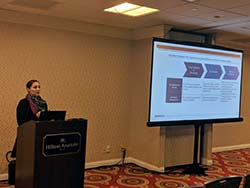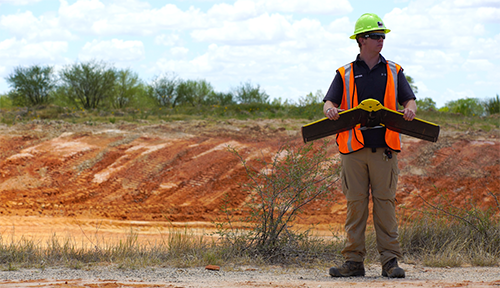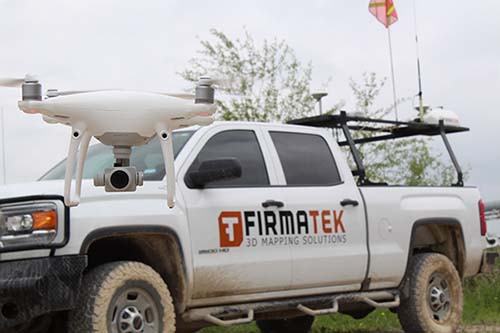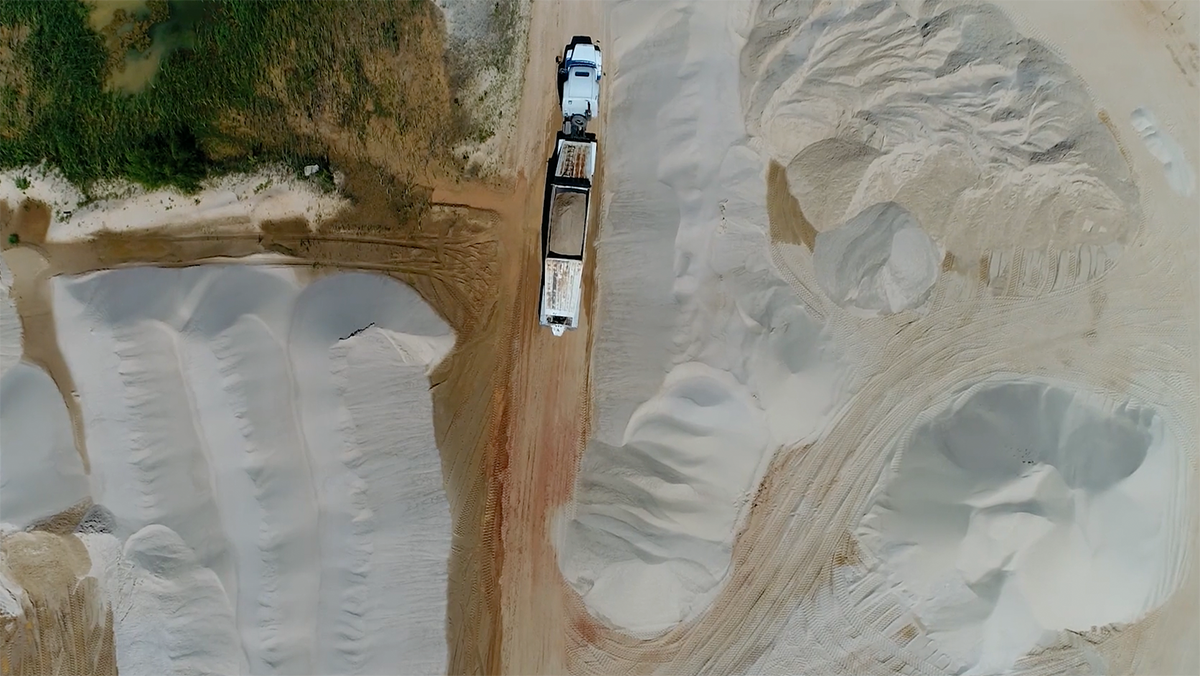Being able to transform drone data into actionable insights that can drive business decisions is becoming more and more of a priority for operators of all types. After all, it’s easier than ever send a drone into the air to gather information, but what’s being done with that data after the flight is complete? How is that information being integrated into or impacting an established workflow? Most users understand that drones can make a given task faster, cheaper or safer, but how are those efficiencies quantified?

Lauren Elmore presenting at DJI AirWorks 2018
 Part of that transition undoubtedly involved realizing that the position of “chief drone officer” was a necessary one for your company, and that’s a made a big difference for you. How has the insight and perspective of a CDO impacted the conversations you’re able to have with clients and even internally? The decision to hire a CDO was an important one for us. We knew we were viewed as a laser company not likely to “make it” in this new world of drones. We needed a drone industry insider to help us break into the drone world. We needed to show we were a player and intend to stay. But more than that, we knew we needed someone who could help us stay on the forefront of drone technology, who knew people in the drone industry, and who could help us become thought leaders.It has been very helpful with our clients to be able to bring in a “drone” expert to our conversations with clients. Our CDO is constantly working on finding new technology, whether it’s new sensors or drones, to bring to our clients as options. If a client has a question about a use case, he will dig in and see how we can do it, what technology we need to serve the client, and figure out where else we may be able to use similar ideas with other clients.Internally, we are able to have more informed discussions and stay up on the new tools available to us. It helps us keep pushing the envelope and continuing to develop new solutions for clients. Your clients are clearly having success, as Turner Mining recently announced how they were able to streamline billing and reconciliation. Has it made a bigger impact for management (in terms of the bottom line) or for production (in terms of making people’s job easier)? I think the bigger impact is with management. The drone solutions are helping managers make better decisions because they have better information. They are building their understanding of the operation each time they fly (building their business intelligence), and using this to make their decisions.That said, there is certainly a production impact as well. They don’t have to stop production to get a survey done and it is extremely easy for the operations guys to fly the drone. At AirWorks 2018, I thought your presentation, "Transform Site Data into Powerful Insights with Drone Technology” was notable for several reasons. Are there any commonalities when it comes to workflow transformations that span a variety of client deliverables which range from point clouds to quarry mapping to aerial ortho images? Across all our clients and deliverables, we strive to give clients more than just data. Sometimes, they do just want data, so a point cloud or ortho image isn’t necessarily “transformed” but the general concept is that it across our deliverables to clients we give them more than a number or data. We provide them with confidence and key insights so that they can make critical business decisions.
Part of that transition undoubtedly involved realizing that the position of “chief drone officer” was a necessary one for your company, and that’s a made a big difference for you. How has the insight and perspective of a CDO impacted the conversations you’re able to have with clients and even internally? The decision to hire a CDO was an important one for us. We knew we were viewed as a laser company not likely to “make it” in this new world of drones. We needed a drone industry insider to help us break into the drone world. We needed to show we were a player and intend to stay. But more than that, we knew we needed someone who could help us stay on the forefront of drone technology, who knew people in the drone industry, and who could help us become thought leaders.It has been very helpful with our clients to be able to bring in a “drone” expert to our conversations with clients. Our CDO is constantly working on finding new technology, whether it’s new sensors or drones, to bring to our clients as options. If a client has a question about a use case, he will dig in and see how we can do it, what technology we need to serve the client, and figure out where else we may be able to use similar ideas with other clients.Internally, we are able to have more informed discussions and stay up on the new tools available to us. It helps us keep pushing the envelope and continuing to develop new solutions for clients. Your clients are clearly having success, as Turner Mining recently announced how they were able to streamline billing and reconciliation. Has it made a bigger impact for management (in terms of the bottom line) or for production (in terms of making people’s job easier)? I think the bigger impact is with management. The drone solutions are helping managers make better decisions because they have better information. They are building their understanding of the operation each time they fly (building their business intelligence), and using this to make their decisions.That said, there is certainly a production impact as well. They don’t have to stop production to get a survey done and it is extremely easy for the operations guys to fly the drone. At AirWorks 2018, I thought your presentation, "Transform Site Data into Powerful Insights with Drone Technology” was notable for several reasons. Are there any commonalities when it comes to workflow transformations that span a variety of client deliverables which range from point clouds to quarry mapping to aerial ortho images? Across all our clients and deliverables, we strive to give clients more than just data. Sometimes, they do just want data, so a point cloud or ortho image isn’t necessarily “transformed” but the general concept is that it across our deliverables to clients we give them more than a number or data. We provide them with confidence and key insights so that they can make critical business decisions.  Your presentation had a whole section titled “Transforming Data into Insights”, and that’s something I want to break down with you. This is a concept I’ve been focused on lately, but it’s often so amorphous. How do you approach getting specific with it in a meaningful way to clients and potential clients? I agree that this is a difficult topic. We try to focus on a couple of key things.First, we focus on how they can use the information that we give them. We like to show some case studies like the Turner Mining Group one, or the general ROI on inventory management. We show clients that what they get from us are insights that they can use, not a tool or way to do analysis themselves.We also try and show that there are those 4 pieces to the process (data capture, data processing, insights, business intelligence). Often we see clients think that the data processing piece is the end that it is just a number or a picture that they need. We try to cast the vision for what could be if we take it the next two steps.A great example of the insights instead of just data is that we had a client recently who for the past few years would get one inventory measurement a year and was always taking a huge write-off. For the past 5 quarters they’ve been doing a combination of monthly and quarterly measurements, this year their write-off will be just 1%. Can you walk us through what it means to go from data capture to business intelligence? What are the biggest challenges that are inherent in this process? It all starts with good data. The data collection process and tools are the critical first step.However, I think where the biggest challenge comes in is that many people stop after getting processed data. They get a basic number or an image and think that is all they can get from a drone solution. So having the expertise and the tools to take it a step further can help get actual insights from the data. We deliver clients key operational metrics that they can then go apply in their business decision-making. That key insight phase seems especially critical, but the trouble there relates to everyone having or needing to gather a different key insight. How have you been able to help clients shape what kind of insight they should be gathering? As you mentioned during the presentation, it doesn’t make sense to gather this data if it doesn’t lead to a change in process or procedure, does it? There are a number of key insights in particular industries, but we agree that especially across industries, everyone needs something different. We like to partner with clients to figure out what will be most useful for them and help them develop what those insights that they need really are.Turner Mining was a good example of how we helped them shape what they could do with it. We worked with them before drones, but we tapped into some of their key issues around disputes on how much was moved and presented a drone solution to help solve that problem.Similarly, we worked with landfills to understand the key drivers of their financial success and regulatory restrictions (airspace and density). Then we worked with them to develop the best ways to show those things to them and help them use the deliverable to make better decisions. What are some examples of the business intelligence you’ve seen companies create/enable/utilize?Many of those distinctions are spelled out in our Turner Mining case study, but to give you one example, Turner helped themselves and their clients streamline the billing and reconciliation process by using Firmatek’s Drone Solutions. Instead of time consuming and costly disputes about how much volume was moved, they have a recognized third-party number every time.We’ve seen incredible differences for clients working with or in landfills as well though. When a landfill is closing a cell, they will request frequent deliverables from us, usually monthly. So we help them closely monitor the closing of the cell so that they can get the most value from it. Historically, they would have just gone based on plans and an annual survey. Landfill clients that are closing a cell now take the information we are giving them and they make adjustments to when they will move into the new cell (potentially delaying large capital expenditures) and increasing the life of the landfill.
Your presentation had a whole section titled “Transforming Data into Insights”, and that’s something I want to break down with you. This is a concept I’ve been focused on lately, but it’s often so amorphous. How do you approach getting specific with it in a meaningful way to clients and potential clients? I agree that this is a difficult topic. We try to focus on a couple of key things.First, we focus on how they can use the information that we give them. We like to show some case studies like the Turner Mining Group one, or the general ROI on inventory management. We show clients that what they get from us are insights that they can use, not a tool or way to do analysis themselves.We also try and show that there are those 4 pieces to the process (data capture, data processing, insights, business intelligence). Often we see clients think that the data processing piece is the end that it is just a number or a picture that they need. We try to cast the vision for what could be if we take it the next two steps.A great example of the insights instead of just data is that we had a client recently who for the past few years would get one inventory measurement a year and was always taking a huge write-off. For the past 5 quarters they’ve been doing a combination of monthly and quarterly measurements, this year their write-off will be just 1%. Can you walk us through what it means to go from data capture to business intelligence? What are the biggest challenges that are inherent in this process? It all starts with good data. The data collection process and tools are the critical first step.However, I think where the biggest challenge comes in is that many people stop after getting processed data. They get a basic number or an image and think that is all they can get from a drone solution. So having the expertise and the tools to take it a step further can help get actual insights from the data. We deliver clients key operational metrics that they can then go apply in their business decision-making. That key insight phase seems especially critical, but the trouble there relates to everyone having or needing to gather a different key insight. How have you been able to help clients shape what kind of insight they should be gathering? As you mentioned during the presentation, it doesn’t make sense to gather this data if it doesn’t lead to a change in process or procedure, does it? There are a number of key insights in particular industries, but we agree that especially across industries, everyone needs something different. We like to partner with clients to figure out what will be most useful for them and help them develop what those insights that they need really are.Turner Mining was a good example of how we helped them shape what they could do with it. We worked with them before drones, but we tapped into some of their key issues around disputes on how much was moved and presented a drone solution to help solve that problem.Similarly, we worked with landfills to understand the key drivers of their financial success and regulatory restrictions (airspace and density). Then we worked with them to develop the best ways to show those things to them and help them use the deliverable to make better decisions. What are some examples of the business intelligence you’ve seen companies create/enable/utilize?Many of those distinctions are spelled out in our Turner Mining case study, but to give you one example, Turner helped themselves and their clients streamline the billing and reconciliation process by using Firmatek’s Drone Solutions. Instead of time consuming and costly disputes about how much volume was moved, they have a recognized third-party number every time.We’ve seen incredible differences for clients working with or in landfills as well though. When a landfill is closing a cell, they will request frequent deliverables from us, usually monthly. So we help them closely monitor the closing of the cell so that they can get the most value from it. Historically, they would have just gone based on plans and an annual survey. Landfill clients that are closing a cell now take the information we are giving them and they make adjustments to when they will move into the new cell (potentially delaying large capital expenditures) and increasing the life of the landfill.  How do you explain the difference between measurement and management? Measurement is the number, often the volume. You certainly have to start here. If you measure it, you can manage it.In order to manage, you need to bring in more data, and ultimately start making decisions. So first, we bring in information like the types of material. Sometimes we bring in permanent bases to get to a total inventory number. With many clients that are having trouble with their inventories, we walk through the results with them and look for patterns. We help them analyze what the issue might be, so that they can make changes in their operation.The major difference is that measurement is simply a number. Management requires analysis and decision-making. When it comes to ROI, we’re talking about a measurable that can vary depending on the company and application, but you mentioned your work with an aggregate company that went from writing off $500K to now only writing down $100K thanks to changing their inventory measurement process from annual to monthly. What can you say about the process this company went through in order to quantify this result?The quantifying was based on the book value of their inventory vs what the annual measurement said. The more challenging part was what they went through during the year to make sure that their numbers stayed in line. This is where the frequent measurements helped them keep their books in line throughout the year. They didn’t have to have their assumptions compounding upon one another month after month, but rather would have a check and make operational and assumption adjustments on a monthly basis. How typical of a result do you think this is? Should companies go into a technology adoption process with expectations around percentages and ROI?I think for many aggregate companies who are measuring only on an annual basis and using assumptions throughout the year, this is a fairly typical result. The degree will vary, but I think most will find significant savings and a high ROI.I also think that they should consider the ROI of a new technology adoption. We often see clients simply caring about the cost of the technology and not looking at the bigger picture of what they can save if they use it. We all do this to a certain extent when we look to buy something new. However, it is especially prevalent in something like stockpile measurement because of the perception that it is a necessary evil for many as well as a big change. So it’s important to show the value they can get outside of just a stockpile number that they have to turn over to corporate.
How do you explain the difference between measurement and management? Measurement is the number, often the volume. You certainly have to start here. If you measure it, you can manage it.In order to manage, you need to bring in more data, and ultimately start making decisions. So first, we bring in information like the types of material. Sometimes we bring in permanent bases to get to a total inventory number. With many clients that are having trouble with their inventories, we walk through the results with them and look for patterns. We help them analyze what the issue might be, so that they can make changes in their operation.The major difference is that measurement is simply a number. Management requires analysis and decision-making. When it comes to ROI, we’re talking about a measurable that can vary depending on the company and application, but you mentioned your work with an aggregate company that went from writing off $500K to now only writing down $100K thanks to changing their inventory measurement process from annual to monthly. What can you say about the process this company went through in order to quantify this result?The quantifying was based on the book value of their inventory vs what the annual measurement said. The more challenging part was what they went through during the year to make sure that their numbers stayed in line. This is where the frequent measurements helped them keep their books in line throughout the year. They didn’t have to have their assumptions compounding upon one another month after month, but rather would have a check and make operational and assumption adjustments on a monthly basis. How typical of a result do you think this is? Should companies go into a technology adoption process with expectations around percentages and ROI?I think for many aggregate companies who are measuring only on an annual basis and using assumptions throughout the year, this is a fairly typical result. The degree will vary, but I think most will find significant savings and a high ROI.I also think that they should consider the ROI of a new technology adoption. We often see clients simply caring about the cost of the technology and not looking at the bigger picture of what they can save if they use it. We all do this to a certain extent when we look to buy something new. However, it is especially prevalent in something like stockpile measurement because of the perception that it is a necessary evil for many as well as a big change. So it’s important to show the value they can get outside of just a stockpile number that they have to turn over to corporate.  If I’m someone that believes drones and the data they gather can create value for my operation, but I have concerns that I’d be able to effectively work through the key insights and business intelligence steps of your process, what would you tell me? Firmatek will help you work through that. We aim to be trusted advisors to our clients. So we can offer suggestions on how to use the information and insights most effectively.
If I’m someone that believes drones and the data they gather can create value for my operation, but I have concerns that I’d be able to effectively work through the key insights and business intelligence steps of your process, what would you tell me? Firmatek will help you work through that. We aim to be trusted advisors to our clients. So we can offer suggestions on how to use the information and insights most effectively.















Comments